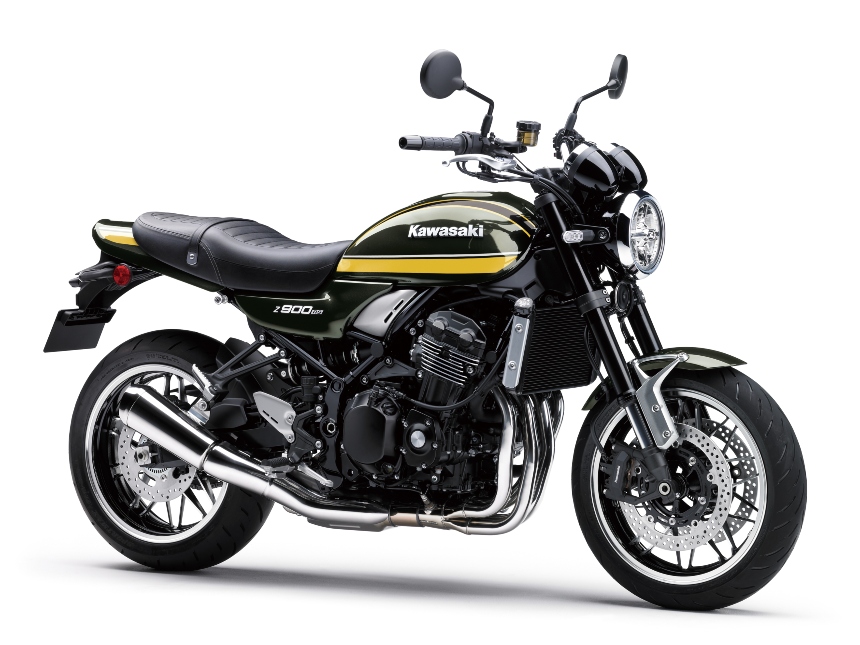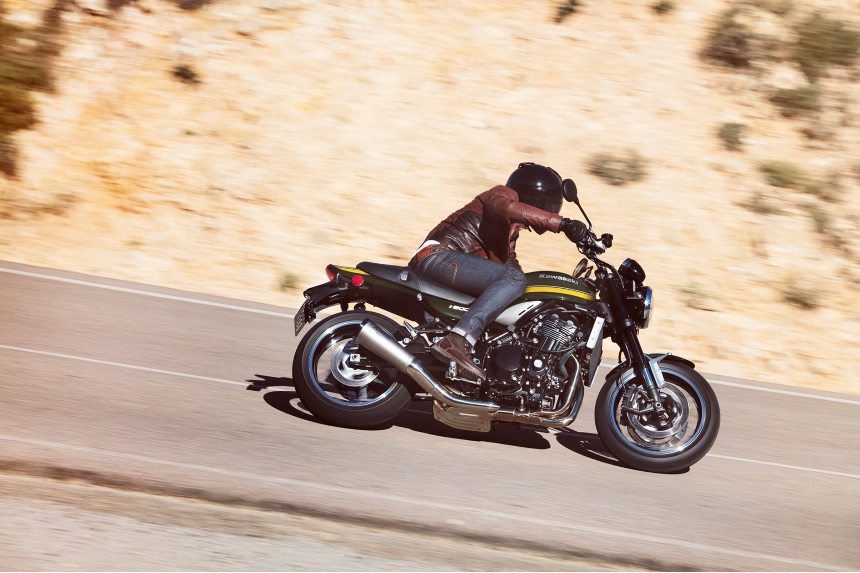Think of a modern day interpretation of a classic motorcycle and you’ll probably have visions of the latest Triumph Bonneville, or maybe a Ducati Scrambler or BMW R nineT, but after spending some time with Kawasaki’s latest Z900RS, we might have just found one of the purest and most underrated retros you can buy today.
Kawasaki launched the RS in 2018. As the name suggests, it is based on the standard Z900, the raucous middleweight naked rival to the Street Triple and MT-09, but the look and vibe are totally different, yet still totally Kawasaki.
Of course, Kawasaki’s most retro machine is the W800 – a Brit bike styled twin that’s inspired by the BSA A7 derived Kawasaki W1, which debuted in 1965, but to most of us the bikes that defined the brand were the big bad inline four Zeds of the Seventies, in particular the Z1 of 1972.
Back in the day, the 130mph Z1 was the fastest production bike in the world. By today’s standards, the Z900RS is hardly considered a superbike, but with 109bhp and a higher top speed than the legend that inspired it, this is most definitely a 21st century machine.
Even so, a glance at the spec sheet suggests there’s nothing much to get excited about by today’s standards. There’s none of the gadgetry we’ve come to expect with modern motorcycles. In a world where most middleweights boast TFT screens, smartphone connectivity and riding modes, the Kawasaki has a two (three if you include ‘off’) setting traction control and, er, well that’s about it. The Kawasaki Z900RS is one of the most analogue new motorcycles you can buy in 2021, and that might well be what makes it so brilliant!
Old school motorcycling
Now 1970s bikes were not really my thing. The Universal Japanese Motorcycles of the time all looked and sounded much the same, and even if the 1000cc fours were the fastest bikes around, it was hard to distinguish them from the more mundane 400s and 500s.
I grew up in the ’80s and started riding in the early ‘90s, a much more interesting time in the development of the modern motorcycle. My dad’s friend had a big Kawasaki GPz1100, but the UJM dinosaurs never really had much appeal to me when you could be riding an RGV250 or KR-1S.
That said, one of my first big bikes was a UJM-ish Kawasaki Zephyr 550, a Hammerite painted pile of poo that had had the life couriered out of it by six not very careful owners by the time it had reached my impoverished hands some time around 1997. It was a truly dreadful thing but the freedom and adventures it brought me mean that I remember it as fondly as any other motorcycle I ever rode or owned.
The point, when I finally get to it, is that (for me) the motorcycle is the vehicle for the journey, not the reason for the journey. Call me old fashioned, but I like simple. There are no ‘joysticks on the switchgear cube’ or ‘comprehensive options menus’ with a Kawasaki Z900RS.
With a few 21st century additions, the switchgear layout and lovely chrome trimmed twin clock set-up is pure traditional motorcycle. Hop on board for the first time and the Z900RS is as familiar as your favourite slippers. It’s the first test bike I’ve ridden in years that hasn’t had me flicking through the owner’s manual, trying to work out how to carry out a simple task.
Kawasaki’s engineers have clearly taken the ‘less is more’ approach with their modern classic, but that in itself is no easy task. Sometimes retro styled bikes, especially those which share their underpinnings with standard nakeds, can look a little gawky when two styles collide, but this looks well proportioned and all the modern sensors and cabling are neatly hidden away or integrated into the design in an unobtrusive way.
My only real gripe is with the radiator, which looks fine from the side on, but which lets the illusion down from in the saddle. The rad is clearly shared with other models in the Kawasaki range, leaving some redundant brackets on show (not to mention an ugly filler cap with a great big warning sticker on it).
It’s shrouded by finishing panels on the standard (non-retro) Z900 but it irritated me mildly when I glanced down from the seat of the RS. It’s nothing that a Dremel and a rattle can couldn’t solve though. It’s also a mark of how much I loved this bike that it’s the only negative thing I could find to put in my notes.
Radiator aside, the look is spot on. From front to back there are homages to the past. The duck bill rear tail piece is pure Z1, as are the rather lovely instrument binnacles. Everything else is modern but subtle, and (radiator aside) it all feels like it’s meant to be there – rather than the first component to be dragged out of the parts bin.
The only real change to the Z900RS for 2021 are the colours, and boy what colours they are. Three options are available. You can specify metalflake black, or a black and grey combo, but the ‘Candytone Green’ of our test bike is a total showstopper. Candy Tone Green and Yellow was one of two options on the 1974 Z1A.
It was love at first sight for me, not just because dark green and yellow makes for a great colour combo but also because the quality of the paintwork is sublime. It looked good when I picked it up on a drab grey morning, but when the sun came out during our video shoot the metal flakes from the lustrous paint just popped into the camera lens, as did the beautiful chromed components.
And if the paint lures you in, the engine melts your heart. Put the key in the ignition (none of this fancy keyless nonsense around here!), thumb that starter and your ears receive a real treat. Fours are not known for their aural experience in the way twins and triples are but the Z900RS is, again, bang on the money.
It’s hard to imagine that it’s a coincidence, and Kawasaki engineers have clearly been burning the midnight oil to not only make the exhaust system look good, but sound great too. There’s a wonderful burble at start up and a howl as you rev through the gearbox. This is on the standard exhaust too. There’s also an accessory system from Akrapovic available too, either individually or as part of the Performance pack.
The engine loves to be revved and, overall, the Z900RS feels light and easy to ride. There’s 109bhp at the right hand but the spread of power is incredibly linear, while the gearbox and clutch are light and accurate, as you’d expect from a modern bike.
One area where the Z900RS makes no effort to imitate its more famous ancestor is in the chassis. Where 1970s superbikes were notorious for their evil handling, poor tyres and wooden brakes, this could not be any more different.
The steel trellis frame is shared with the standard Z900, but where it is usually found painted green and on show on that model, here it is black and in the background. The 41mm upside down forks are fully modern and fully adjustable, as is the horizontally mounted rear shock absorber.
Those who like to ride enthusiastically are probably not looking at the Z900RS in the first place and, at my modest pace, the suspension feels up to the task. Brakes are radially mounted monoblocs with more than enough power and plenty of feel. It’s all very unlike a 1970s superbike, thankfully.
Where the Z1 ran on spoked rims, the Z900RS utilises more modern 17” alloys, albeit with a very unusual thin spoke design inspired by the old-school wire wheels. I personally think they look pretty cool and are a neat talking point.
From the factory, Kawasaki fit Dunlop Sportmax GPR-300 tyres – a decent all-round performer – but the rim sizes allow for a massive range of replacement options for riders who perhaps want a stickier option.

Personally I also loved riding a motorcycle with analogue clocks again. The speedo and rev counter may be old fashioned, but isn’t there just something awesome about watching those needles sweep effortlessly to the right? Between the clocks, in the area where the ‘idiot’ lights were historically found on UJMs, is a well packaged LCD info panel.
LCD dashes are rapidly becoming retro themselves, but this suits the Z900RS down to the ground and contains a large gear indicator and fuel gauge, as well as fuel consumption, clock, trip meters and air temperature. There’s also a 12v power socket under the seat, which can be used for charging devices or powering sat-navs or heated accessories.
The saddle is another work of art. As a smaller (165cm) rider I found the Z900RS easily manageable but, with a claimed seat height of 835mm, it feels a little taller than most middleweights. In a large part that’s down to the fact that the seat itself is very generously padded.
There’s always a trade off between comfort and a low seat height, but Kawasaki has prioritised making it nice and comfy and I’d agree that they’ve made the right call for most riders. My derriere certainly had no complaints and for riders who would prefer to be closer to the ground, there’s always the option of a 35mm lower saddle as an accessory.
List price for the Kawasaki Z900RS starts at £10,649 for the plain black version, with a £300 premium for the two-tone model we tested. That’s pretty strong money for a 900 and puts it up against some stiff competition in a crowded marketplace.
Triumph’s Bonneville T120, arguably the benchmark retro on the market today, starts at £10,800, and if you’re looking for a middle-weight naked and aren’t fussed about the modern classic look there’s even more choice out there. Triumph’s Street Triple RS, the Yamaha MT-09SP and even Kawasaki’s own Z1000 all deliver more spec and greater performance for less money.
But what you get with the Z900RS is a motorcycle that is greater than the sum of its parts. It’s a retro with real character and true to the Kawasaki that made the world sit up and notice in the 1970s.
It’s got some beautiful details to it and it was noticeable how many random members of the public came up to us while we were filming the Z900RS to comment on our ‘beautiful’ bike, or to regale us with tales of family members who rode back in the day. It’s a bike that I loved looking at and listening to, but when it came to riding I just enjoyed the fact that it’s simple and faff free.
Sometimes you find love at the most unexpected times. I’d approached the Z900RS with a heavy dose of ambivalence, but I think I might be smitten by it. It looks amazing in the metal, has a gorgeous deep bark and a playful personality. I’d rather like a second date…



